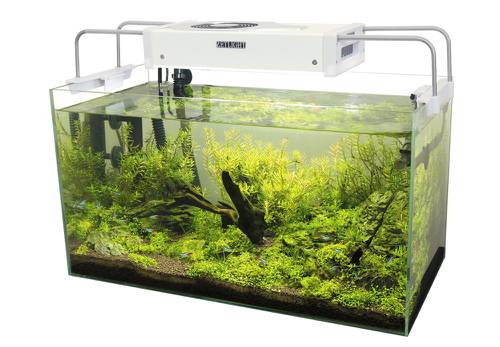
FAQ About Indoor Plant Lighting for Aquatic Systems

What type of lighting is best for indoor aquatic plant systems?
The best type of lighting for indoor aquatic plant systems depends on the plants you are keeping. Generally, LED lights are a popular choice due to their energy efficiency, longevity, and ability to provide a full spectrum of light. Full-spectrum LED lighting supports photosynthesis by replicating sunlight, which is ideal for most aquatic plants.

Why is light spectrum important for aquatic plants?
Light spectrum is crucial for aquatic plants because different wavelengths are used in various stages of photosynthesis. Blue light supports vegetative growth, while red light enhances flowering and fruiting. A full-spectrum light provides a balanced range of wavelengths that supports healthy plant growth and development in aquatic systems.

How many hours of light do aquatic plants need each day?
Aquatic plants generally require about 8 to 12 hours of light per day. The exact duration can vary depending on the species and growth stage of the plants. It's essential to simulate a natural day/night cycle, as too much or too little light can lead to algae growth or poor plant health.

How does light intensity affect aquatic plant growth?
Light intensity influences the rate of photosynthesis in aquatic plants. Low light can slow growth and result in pale, weak plants, while excessive light may encourage algae growth and damage plant tissues. The optimal intensity depends on the plant species; some require high light, while others thrive in low-light conditions.

Can I use regular household bulbs for my aquatic plants?
Regular household bulbs are generally not recommended for aquatic plants because they lack the necessary spectrum of light and intensity required for photosynthesis. Instead, using lights specifically designed for plant growth, like full-spectrum LEDs, will yield better results for maintaining healthy aquatic plants.

What are the benefits of using LED lights for aquatic plants?
LED lights offer several benefits for aquatic plants, including energy efficiency, a long lifespan, and the ability to emit a full spectrum of light suitable for photosynthesis. They are also available in various intensities and colors, which can be adjusted to mimic natural sunlight or specific lighting conditions.

How do I determine the right light intensity for my aquatic system?
Determining the right light intensity involves understanding the needs of your specific aquatic plants. Research the light requirements of each plant species. As a general rule, low-light plants need about 15-25 lumens per liter, medium-light plants require 25-50 lumens per liter, and high-light plants need 50-100 lumens per liter.

What are the signs of inadequate lighting in aquatic plants?
Signs of inadequate lighting in aquatic plants include yellowing leaves, weak or leggy growth, and poor overall plant health. In some cases, you may also notice excessive algae buildup or that plants aren't thriving as expected. Adjusting light intensity or duration can help resolve these issues.

How can I prevent algae growth in my indoor aquatic system?
To prevent algae growth in your indoor aquatic system, maintain a balanced lighting schedule of 8 to 12 hours daily, avoid overfeeding, and ensure your plants are receiving the right spectrum and intensity of light. Regular water changes and maintaining proper nutrient levels also help keep algae under control.

Is it necessary to adjust lighting with plant growth changes?
Yes, it's often necessary to adjust the lighting as plants grow and their needs change. As plants mature, they may require different light intensities or durations. Regularly monitoring your plants' growth and health will guide you in making the necessary adjustments to the lighting.

How does the depth of the aquarium affect lighting needs?
The depth of an aquarium affects lighting needs because light intensity decreases as it penetrates water. Deeper tanks require stronger or more focused lighting to ensure that the lower levels receive adequate light for photosynthesis. Adjustable lighting fixtures can help accommodate varying tank depths.

Can I automate the lighting for my aquatic plant system?
Yes, automating the lighting for your aquatic plant system is possible and often recommended. Using timers or programmable lighting systems ensures consistent light cycles, reduces manual intervention, and helps maintain a stable environment for plant growth.

How do different light colors affect aquatic plant growth?
Different light colors, corresponding to different wavelengths, have unique effects on aquatic plant growth. Blue light promotes vegetative growth and leaf development, red light is beneficial for flowering, and green light often has little to no effect, as it's least absorbed by plants. A balanced spectrum incorporating these colors supports comprehensive plant health.

Should all aquariums have the same lighting setup?
No, not all aquariums should have the same lighting setup. The appropriate setup depends on the specific requirements of the plants and fish within the tank, the size and depth of the aquarium, and other environmental factors unique to each setup. It's important to tailor lighting solutions to meet the needs of your specific system.

What is PAR in relation to aquarium lighting?
PAR (Photosynthetically Active Radiation) is a measure of the usable light spectrum (400 to 700 nanometers) that aquatic plants use for photosynthesis. It's an important consideration when selecting lighting as it indicates whether a light source can effectively support plant growth. PAR meters can be used to measure this in your aquatic system.

Are there any risks involved with using too much lighting in aquatic systems?
Yes, using too much lighting in aquatic systems can lead to problems such as excessive algae growth, temperature increases, and photoinhibition, where too much light damages plant cells. Balancing light intensity and duration is crucial to prevent these issues and maintain a healthy ecosystem.

How do I choose a lighting timer for my aquatic plant system?
When choosing a lighting timer for your aquatic plant system, look for features such as programmable settings, reliability, and ease of use. Digital timers offer more flexibility with multiple programs and precise control, whereas analog timers are simpler but may lack advanced functionality.

Can lighting affect the coloration of aquatic plants?
Yes, lighting can significantly affect the coloration of aquatic plants. Adequate and appropriate lighting helps maintain vibrancy and health, while insufficiencies might result in dull or discolored plants. Certain light spectrums, like reds and blues, can enhance color expression in some plant species.

What role do reflectors play in aquarium lighting?
Reflectors play a critical role in maximizing the efficiency of aquarium lighting by directing and spreading the light evenly across the tank. This ensures that light reaches all parts of the aquarium, improving plant growth and minimizing shadows or dark areas.

What maintenance is required for aquarium lighting systems?
Maintenance for aquarium lighting systems includes regular cleaning of light fixtures to prevent dust buildup, checking and replacing bulbs when they depreciate or burn out, and monitoring the integrity of electrical components. Ensuring consistent performance is key to effective plant growth and health.
